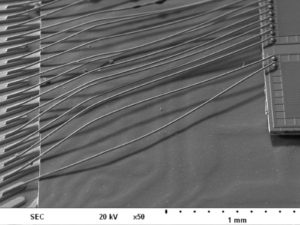Crack Chip PIC18F4458 Firmware
Crack Chip PIC18F4458 embedded memory which include flash and eeprom and extract firmware out from the memory, then copy the content into blank Microcontroller PIC18F4458 to provide the same functions;

Crack Chip PIC18F4458 embedded memory which include flash and eeprom and extract firmware out from the memory, then copy the content into blank Microcontroller PIC18F4458 to provide the same functions
The analog reference voltage is software selectable to either the device’s positive and negative supply voltage (VDD and VSS), or the voltage level on the RA3/AN3/VREF+ and RA2/AN2/VREF-/CVREF pins.
The A/D Converter has a unique feature of being able to operate while the device is in Sleep mode. To operate in Sleep, the A/D conversion clock must be derived from the A/D’s internal RC oscillator.
The output of the sample and hold is the input into the Converter, which generates the result via successive approximation.
A device Reset forces all registers to their Reset state. This forces the A/D module to be turned off and any conversion in progress is aborted.
Each port pin associated with the A/D Converter can be configured as an analog input or as a digital I/O. The ADRESH and ADRESL registers contain the result of the A/D conversion. When the A/D conversion is complete, the result is loaded into the ADRESH:ADRESL register pair, the GO/DONE bit (ADCON0 register) is cleared and the A/D Interrupt Flag bit, ADIF, is set to facilitate the process of Readout MCU firmware.
The block diagram of the A/D module is shown in Figure 2-1. The value in the ADRESH:ADRESL registers is unknown following Power-on and Brown-out Resets, and is not affected by any other Reset. After the A/D module has been configured as desired, the selected channel must be acquired before the conversion is started.
The analog input channels must have their corresponding TRIS bits selected as an input. To determine acquisition time, see Section 2.1 “A/D Acquisition Requirements”. After this acquisition time has elapsed, the A/D conversion can be started. An acquisition time can be programmed to occur between setting the GO/DONE bit and the actual start of the conversion.
The following steps should be followed to perform an A/D conversion:
1. Configure the A/D module:
· Configure analog pins, voltage reference and digital I/O (ADCON1)
· Select A/D input channel (ADCON0)
· Select A/D acquisition time (ADCON2)
· Select A/D conversion clock (ADCON2)
· Turn on A/D module (ADCON0)
Configure A/D interrupt (if desired):
· Clear ADIF bit
· Set ADIE bit
· Set GIE bit
Wait the required acquisition time (if required)
Start conversion:
· Set GO/DONE bit (ADCON0 register)
Wait for A/D conversion to complete, by either:
· Polling for the GO/DONE bit to be cleared OR
· Waiting for the A/D interrupt Read A/D Result registers (ADRESH:ADRESL); clear bit ADIF, if required.
For next conversion, go to step 1 or step 2, as required. The A/D conversion time per bit is defined as TAD. A minimum wait of 2 TAD is required before the next acquisition starts.
Tags: crack chip encrypted archive,crack chip encrypted code,crack chip encrypted content,crack chip encrypted data,crack chip encrypted eeprom,crack chip encrypted file,crack chip encrypted firmware,crack chip encrypted information,crack chip encrypted memory,crack chip encrypted program

